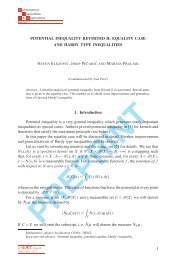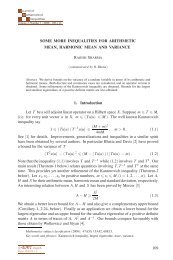NONLINEAR INTEGRAL INEQUALITIES INVOLVING ... - Ele-Math
NONLINEAR INTEGRAL INEQUALITIES INVOLVING ... - Ele-Math
NONLINEAR INTEGRAL INEQUALITIES INVOLVING ... - Ele-Math
You also want an ePaper? Increase the reach of your titles
YUMPU automatically turns print PDFs into web optimized ePapers that Google loves.
<strong>NONLINEAR</strong> <strong>INTEGRAL</strong> <strong>INEQUALITIES</strong> 815<br />
where the function K1 is nondecreasing and satisfies K1(t0) = Ψ(M) and, due to (2.10)<br />
and (2.13),<br />
z(t) K(t) Ψ −1 K1(t) holds for t ∈ [t0,t1). (2.14)<br />
Differentiate the function K1 and use its monotonicity (observe Definition 2.1) and<br />
(2.14) to obtain<br />
K ′ <br />
1(t) = fi(αi(t))q ψ −1 z(αi(t)) <br />
α ′ i(t)<br />
n<br />
∑<br />
i=1<br />
+<br />
<br />
q<br />
m<br />
∑<br />
j=1<br />
<br />
g j(β j(t))q ψ −1 z(β j(t)) <br />
β ′ j (t)<br />
ψ −1<br />
Ψ −1 K1(t) n<br />
∑ fi(αi(t))α<br />
i=1<br />
′ i(t)+<br />
From (2.15) and (2.5), we get<br />
(W ◦ K1) ′ (t) =<br />
<br />
K ′ 1 (t)<br />
<br />
q ψ−1 <br />
Ψ−1K1(t) <br />
n<br />
∑<br />
i=1<br />
fi(αi(t))α ′ i(t)+<br />
m<br />
∑<br />
j=1<br />
m<br />
∑<br />
j=1<br />
g j(β j(t))β ′ <br />
j(t) .<br />
g j(β j(t))β ′ j(t).<br />
Integrate (2.16) from t0 to t ∈ [t0,t1] and change the variables to get<br />
(2.15)<br />
(2.16)<br />
W K1(t) = W Ψ(M) + A(t), (2.17)<br />
where the function A is defined by (2.7). Since W −1 is increasing and since, due to<br />
(2.9) and (2.14), u(t) ψ−1 (z(t)) ψ−1 <br />
Ψ−1K1(t) <br />
, (2.17) implies the required<br />
inequality (2.3). <br />
COROLLARY 2.4. Let k = 0 and φ(t) ≡ 0. Suppose (A 3 )–(A 7 ) hold. Then for<br />
t0 t t2 , the inequality<br />
u(t) ψ −1<br />
<br />
Ψ −1<br />
<br />
W −1<br />
<br />
A(t)<br />
<br />
holds, where<br />
t2 = sup<br />
<br />
τ ∈ [t0,T) : A(t) ∈ Dom W −1 , W −1 A(t) ∈ Dom Ψ −1<br />
and Ψ −1<br />
W −1 A(t) <br />
∈ Dom ψ −1 <br />
for t ∈ [t0,τ] .<br />
Proof. This claim follows from Theorem 2.3 by choosing an arbitrary ε > 0, letting<br />
k = φ(t) = ε , and taking the limit as ε → 0. <br />
Note that the inequalities (2.1), (2.2) could have another type of solution as follows,<br />
which is simpler than (2.3) but the used integral function is more complicated.




